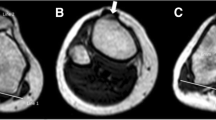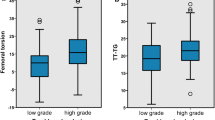Abstract
Purpose
The aim of this study was to investigate the association of femoral (FT), tibial (TT), and knee torsion (KT) on the patella tilt (PT), the axial engagement index (AEI), and the tibial tuberosity–trochlear groove distance (TTTG).
Methods
Femoral torsion, tibial torsion, knee torsion, patella tilt, the axial engagement index, the TTTG, and trochlear dysplasia were retrospectively evaluated on 59 patients suffering from recurrent patella instability or anterior knee pain with 118 torsional lower limb magnetic resonance imaging studies.
Results
FT and TT did not show any significant associations with TTTG, PT, and AEI (n.s.). KT was significantly associated with a higher TTTG, higher PT, and lower AEI (all, p < 0.001). Higher grade trochlear dysplasia was associated with a higher PT and lower AEI (both, p < 0.001). The Dejour classification showed no significant association with FT, TT, KT, and TTTG (n.s.). All measurement parameters showed an excellent interrater agreement (ICC 0.89–0.97).
Conclusions
Static patella tilt and patellofemoral axial engagement in knee extension are mainly influenced by knee torsion, TTTG, and trochlear dysplasia but not by femoral or tibial torsion. These findings help to understand the underlying reasons for the patella position in knee extensions in CT and MRI investigations in patients suffering from patella instability and patellofemoral pain syndrome.
Level of evidence
III.


Similar content being viewed by others
Abbreviations
- FT:
-
Femoral torsion
- TT:
-
Tibial torsion
- KT:
-
Knee torsion
- PT:
-
Patellar tilt
- AEI:
-
Axial engagement
- TTTG:
-
Tibial tuberosity–trochlear groove distance
References
Abadie P, Galaud B, Michaut M, Fallet L, Boisrenoult P, Beaufils P (2009) Distal femur rotational alignment and patellar subluxation: a CT scan in vivo assessment. Orthop Traumatol Surg Res 95:267–271
Airanow S, Zippel H (1990) Femoro-tibial torsion in patellar instability. A contribution to the pathogenesis of recurrent and habitual patellar dislocations. Beitr Orthop Traumatol 37:311–316
Askenberger M, Janarv PM, Finnbogason T, Arendt EA (2017) Morphology and anatomic patellar instability risk factors in first-time traumatic lateral patellar dislocations. Am J Sports Med 45:50–58
Balcarek P, Oberthur S, Hopfensitz S, Frosch S, Walde TA, Wachowski MM et al (2014) Which patellae are likely to redislocate? Knee Surg Sports Traumatol Arthrosc 22:2308–2314
Balcarek P, Radebold T, Schulz X, Vogel D (2019) Geometry of torsional malalignment syndrome: trochlear dysplasia but not torsion predicts lateral patellar instability. Orthop J Sports Med 7:2325967119829790
Balcarek P, Terwey A, Jung K, Walde TA, Frosch S, Schuttrumpf JP et al (2013) Influence of tibial slope asymmetry on femoral rotation in patients with lateral patellar instability. Knee Surg Sports Traumatol Arthrosc 21:2155–2163
Biedert RM (2008) Osteotomies. Orthopade 37:872
Chassaing V, Zeitoun JM, Camara M, Blin JL, Marque S, Chancelier MD (2017) Tibial tubercle torsion, a new factor of patellar instability. Orthop Traumatol Surg Res 103:1173–1178
Dejour D, Le Coultre B (2007) Osteotomies in patello-femoral instabilities. Sports Med Arthrosc 15:39–46
Dejour H, Walch G, Nove-Josserand L, Guier C (1994) Factors of patellar instability: an anatomic radiographic study. Knee Surg Sports Traumatol Arthrosc 2:19–26
Dickschas J, Harrer J, Pfefferkorn R, Strecker W (2012) Operative treatment of patellofemoral maltracking with torsional osteotomy. Arch Orthop Trauma Surg 132:289–298
Diederichs G, Kohlitz T, Kornaropoulos E, Heller MO, Vollnberg B, Scheffler S (2013) Magnetic resonance imaging analysis of rotational alignment in patients with patellar dislocations. Am J Sports Med 41:51–57
Eckhoff DG, Brown AW, Kilcoyne RF, Stamm ER (1997) Knee version associated with anterior knee pain. Clin Orthop Relat Res 339:152–155
Eckhoff DG, Montgomery WK, Kilcoyne RF, Stamm ER (1994) Femoral morphometry and anterior knee pain. Clin Orthop Relat Res 302:64–68
Erkocak OF, Altan E, Altintas M, Turkmen F, Aydin BK, Bayar A (2016) Lower extremity rotational deformities and patellofemoral alignment parameters in patients with anterior knee pain. Knee Surg Sports Traumatol Arthrosc 24:3011–3020
Fleiss J (1986) The design and analysis of clinical experiments. Wiley, New Yoek
Freedman BR, Sheehan FT (2013) Predicting three-dimensional patellofemoral kinematics from static imaging-based alignment measures. J Orthop Res 31:441–447
Fucentese SF (2018) Patellofemoral instability. Orthopade 47:77–86
Fulkerson JP, Schutzer SF, Ramsby GR, Bernstein RA (1987) Computerized tomography of the patellofemoral joint before and after lateral release or realignment. Arthroscopy 3:19–24
Grelsamer RP, Weinstein CH, Gould J, Dubey A (2008) Patellar tilt: the physical examination correlates with MR imaging. Knee 15:3–8
Guilbert S, Chassaing V, Radier C, Hulet C, Remy F, Chouteau J et al (2013) Axial MRI index of patellar engagement: a new method to assess patellar instability. Orthop Traumatol Surg Res 99:S399–S405
Hinterwimmer S, Rosenstiel N, Lenich A, Waldt S, Imhoff AB (2012) Femoral osteotomy for patellofemoral instability. Unfallchirurg 115:410–416
Iliadis AD, Jaiswal PK, Khan W, Johnstone D (2012) The operative management of patella malalignment. Open Orthop J 6:327–339
Jend HH, Heller M, Dallek M, Schoettle H (1981) Measurement of tibial torsion by computer tomography. Acta Radiol Diagn (Stockh) 22:271–276
Kaiser P, Attal R, Kammerer M, Thauerer M, Hamberger L, Mayr R et al (2016) Significant differences in femoral torsion values depending on the CT measurement technique. Arch Orthop Trauma Surg 136:1259–1264
Kaiser P, Schmoelz W, Schoettle P, Zwierzina M, Heinrichs C, Attal R (2017) Increased internal femoral torsion can be regarded as a risk factor for patellar instability—a biomechanical study. Clin Biomech (Bristol, Avon) 47:103–109
Laugharne E, Bali N, Purushothamdas S, Almallah F, Kundra R (2016) Variability of measurement of patellofemoral indices with knee flexion and quadriceps contraction: an MRI-based anatomical study. Knee Surg Relat Res 28:297–301
Liebensteiner MC, Ressler J, Seitlinger G, Djurdjevic T, El Attal R, Ferlic PW (2016) High femoral anteversion is related to femoral trochlea dysplasia. Arthroscopy 32:2295–2299
Lin YF, Jan MH, Lin DH, Cheng CK (2008) Different effects of femoral and tibial rotation on the different measurements of patella tilting: an axial computed tomography study. J Orthop Surg Res 3:5
Liodakis E, Doxastaki I, Chu K, Krettek C, Gaulke R, Citak M et al (2012) Reliability of the assessment of lower limb torsion using computed tomography: analysis of five different techniques. Skelet Radiol 41:305–311
Nelitz M (2018) Femoral derotational osteotomies. Curr Rev Musculoskelet Med 11:272–279
Petersen W, Ellermann A, Gosele-Koppenburg A, Best R, Rembitzki IV, Bruggemann GP et al (2014) Patellofemoral pain syndrome. Knee Surg Sports Traumatol Arthrosc 22:2264–2274
Post WR, Teitge R, Amis A (2002) Patellofemoral malalignment: looking beyond the viewbox. Clin Sports Med 21:521–546
Powers CM (2003) The influence of altered lower-extremity kinematics on patellofemoral joint dysfunction: a theoretical perspective. J Orthop Sports Phys Ther 33:639–646
Powers CM, Shellock FG, Pfaff M (1998) Quantification of patellar tracking using kinematic MRI. J Magn Reson Imaging 8:724–732
Saggin PR, Saggin JI, Dejour D (2012) Imaging in patellofemoral instability: an abnormality-based approach. Sports Med Arthrosc Rev 20:145–151
Seitlinger G, Scheurecker G, Hogler R, Labey L, Innocenti B, Hofmann S (2012) Tibial tubercle-posterior cruciate ligament distance: a new measurement to define the position of the tibial tubercle in patients with patellar dislocation. Am J Sports Med 40:1119–1125
Souza RB, Draper CE, Fredericson M, Powers CM (2010) Femur rotation and patellofemoral joint kinematics: a weight-bearing magnetic resonance imaging analysis. J Orthop Sports Phys Ther 40:277–285
Takagi S, Sato T, Watanabe S, Tanifuji O, Mochizuki T, Omori G et al (2018) Alignment in the transverse plane, but not sagittal or coronal plane, affects the risk of recurrent patella dislocation. Knee Surg Sports Traumatol Arthrosc 26:2891–2898
Teitge RA (2006) Osteotomy in the treatment of patellofemoral instability. Tech Knee Surg 5:2–18
Thomas S, Rupiper D, Stacy GS (2014) Imaging of the patellofemoral joint. Clin Sports Med 33:413–436
Van Haver A, De Roo K, De Beule M, Labey L, De Baets P, Dejour D et al (2015) The effect of trochlear dysplasia on patellofemoral biomechanics: a cadaveric study with simulated trochlear deformities. Am J Sports Med 43:1354–1361
Waidelich HA, Strecker W, Schneider E (1992) Computed tomographic torsion-angle and length measurement of the lower extremity. The methods, normal values and radiation load. Rofo 157:245–251
Waldt S, Rummeny EJ (2012) Imaging of patellofemoral instability. Radiologe 52:1003–1011
Funding
There were no funding sources.
Author information
Authors and Affiliations
Contributions
All authors stated on the manuscript were fully involved in evaluating the study and writing the manuscript.
Corresponding author
Ethics declarations
Conflict of interest
The authors declare that they have no competing interests.
Ethical approval
Institutional review board approval was granted by means of a general waiver for scientific studies with retrospective data analysis (Local research ethics committee, Medical University Innsbruck; 20th February 2009).
Additional information
Publisher's Note
Springer Nature remains neutral with regard to jurisdictional claims in published maps and institutional affiliations.
Rights and permissions
About this article
Cite this article
Kaiser, P., Loth, F., Attal, R. et al. Static patella tilt and axial engagement in knee extension are mainly influenced by knee torsion, the tibial tubercle–trochlear groove distance (TTTG), and trochlear dysplasia but not by femoral or tibial torsion. Knee Surg Sports Traumatol Arthrosc 28, 952–959 (2020). https://doi.org/10.1007/s00167-019-05588-y
Received:
Accepted:
Published:
Issue Date:
DOI: https://doi.org/10.1007/s00167-019-05588-y




